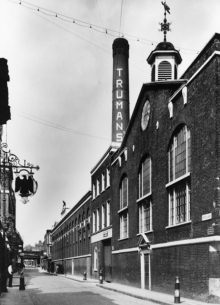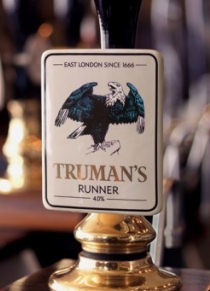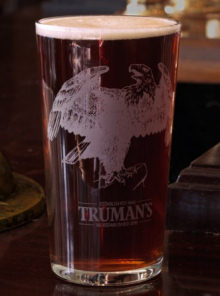 |
 |
|

|
|

|
 |
home
about
Protz
features
A-Z
books
|
|
Protz:
features
reviews
tastings
news & events
books
|

| |
Truman's hops back to Cockneyville
by Willard Clarke, 2010
My earliest image of beer was a giant advertising hoarding for Truman's that stood between the Boleyn Tavern in East London and West Ham United's football ground. It showed a cartoon image of a pirate with a peg leg and a parrot on his shoulder hopping across the hoarding. The memorable slogan was "There's more hops in Ben Truman".
As my interest in beer developed, I discovered that East London was a treasure trove of brewers, including Charrington's, Manns, Truman's and Watney's. They were all based in the Bethnal Green and Whitechapel area, which suggests that in the 17th, 18th and 19th centuries, despite the dreadful poverty and squalor in the East End, the water for brewing must have been of the highest quality.
| Those brewers have all gone and the fate of Truman's was especially hard to take. It opened in 1666 and was based in Brick Lane in Whitechapel, infamous as Jack the Ripper's base but better known today for its infinite number of curry houses. Truman's distinctive chimney still stands but the brewery is now divided into a warren of small offices and enterprises.
Truman's was an enormous business and at its peak in the 19th century was one of the biggest brewers in the world. Benjamin Truman and his successors built their fortune on mild, porter and stout
and they opened a second plant in Burton-on-Trent at the height of the pale ale craze in the 19th century.
In the 20th century, the company had the misfortune to get caught up in the fire-storm of mergers, takeovers and closures that created the "Big Six" national brewers in the 1970s.
|
|
 |
In 1971, Watney Mann went into battle with Grand Metropolitan, both of which wanted to buy Truman's. Grand Met was successful and a year later bought Watney Mann, forming a mighty Watney Mann & Truman conglomerate. Inevitably, Grand Met decided to consolidate and concentrate production at one major centre, Watney's Stag Brewery in Mortlake. Truman's stopped brewing and the historic Black Eagle site closed in 1989.
 |
|
Now Truman's is back. London beer enthusiasts James Morgan and Michael-George Hemus have revived the name and launched a cask ale called Truman's Runner. It has gone on sale in several
pubs in the East End.
They have spent long months in the London Metropolitan Archives researching Truman's, its history and its recipes. Most importantly, they needed permission from the owner of the Truman's legacy
to use the brand name and Black Eagle logo. The owner - are you sitting comfortably? - is Heineken.
In the 1990s, Watney's left brewing. It sold its remaining plants to Courage, in return for Courage's pubs. Courage in turn became part of Scottish & Newcastle, which is now owned by Heineken. This is how the Truman's legacy ended up in the hands of a giant Dutch brewer.
|
Morgan and Hemus could have launched a fashionable, golden bitter but they have opted instead for a firmly traditional, deep copper-coloured beer. The name Runner recalls the period at the turn of the 20th century when brewers such as Truman's were turning way from porters, stouts and India Pale Ales that needed long months of maturation in giant wooden vats. The big brewers had bought large estates of tied houses and wanted beers that could be served quickly after a brief second fermentation in pub cellars. The result was "running beers", today's cask beer or real ale.
Truman's Runner is brewed at present by the Nethergate Brewery in Essex. Truman's had a major presence in Essex, with a maltings in Long Melford and a bottling plant at West Bergholt, both within shouting distance of Nethergate in Pentlow. Morgan and Hemus have been taken under the experienced wing of Nethergate's owner, Dick Burge, head brewer Tom Knox and sales manager Roger Clark.
But the Truman's men plan to build a brewery in East London. They are well aware of the fact that beer, however good, tends to lose its credibility if it's brewed under licence, away from its home base.
James Morgan says: "We will build a new Truman's brewery in East London as soon as it's financially sustainable to do so. As plans stand, that's likely to be late 2012 or early 2013. In order to build a business that will enable us to open a brewery, we need the support of publicans. Thankfully, there are some excellent publicans who can see the merit in re-launching Truman's and helping to bring brewing on a commercial scale back to East London."
| Morgan adds that he and Hemus have designed a beer to suit the tastes of both new drinkers and experienced cask ale drinkers. In the future, they hope to recreate some of the original Truman recipes.
Truman's Runner, 4%, is brewed with pale, chocolate, rye and wheat malts and is hopped with Fuggles, Goldings and Styrian Goldings. It has a deep copper-red colour, a spicy and fruit aroma with a powerful hint of chocolate, a fruity and bitter palate, and a complex finish that offers peppery hops, rich chocolate and fruit, and a fresh bread maltiness.
The beer is on sale at the Scolt Head, Culford Road, London N1, the Water Poet, Folgate Street E1 and the Carpenters Arms E2. There'll be an official launch for the beer in September. I shall hop along and help welcome Truman's back to Cockneyville.
|
|
 |
The back story
The brewery that became Truman's started life on a plot of land in open countryside in what is now Brick Lane, Whitechapel. Joseph Truman joined Bucknall's Brewhouse in 1666 and became manager in 1697. Ben Truman, whose name was to become a brand, joined in 1722, and was later knighted. The brewery flourished and built its reputation on porter, with strong versions, including Imperial Stout, exported to Europe and Russia.
The Black Eagle Brewery, which replaced the original plant, was built in 1724. It employed 1,000 people and it became the biggest brewery in London and the second biggest in Britain after Bass in Burton-on-Trent. Sir Benjamin Truman died in 1780. He had no sons and the brewery passed to his nephews. In 1789, ownership passed to Sampson Hanbury and his nephew, Thomas Fowell Buxton, who later became an MP.
The company, known as Truman, Hanbury & Buxton, invested in new technology, including steam power. In the 1830s it was producing around 200,000 barrels of beer a year. In order to cash in on the growing demand for pale ale and India Pale Ale, Truman's commissioned a second brewery in Burton-on-Trent where it could make use of the mineral-rich waters of the Trent Valley to fashion its own pale ales.
By the end of the century, and in common with many brewers of the day, Truman's ran into financial difficulties as a result of unpaid loan from publicans. As a result, Truman, Hanbury & Buxton became a limited company in order to raise additional funds and investment.
In the 20th century, the brewery flourished again. Once it was possible to "Burtonise" brewing liquor by adding salts, Truman's sold the Burton brewery and concentrated production at Brick Lane. Mild, pale ale and bitter became the main brands, replacing porters, stouts and IPAs that needed long periods of maturation.
|
|
|
home
about
Protz
features
A-Z
books
|